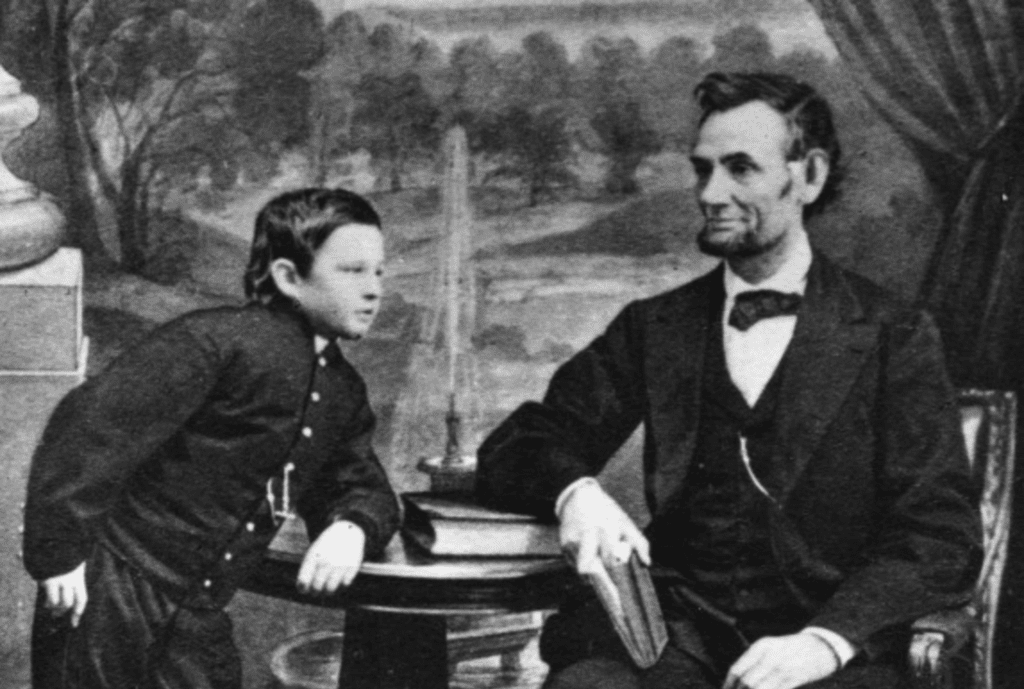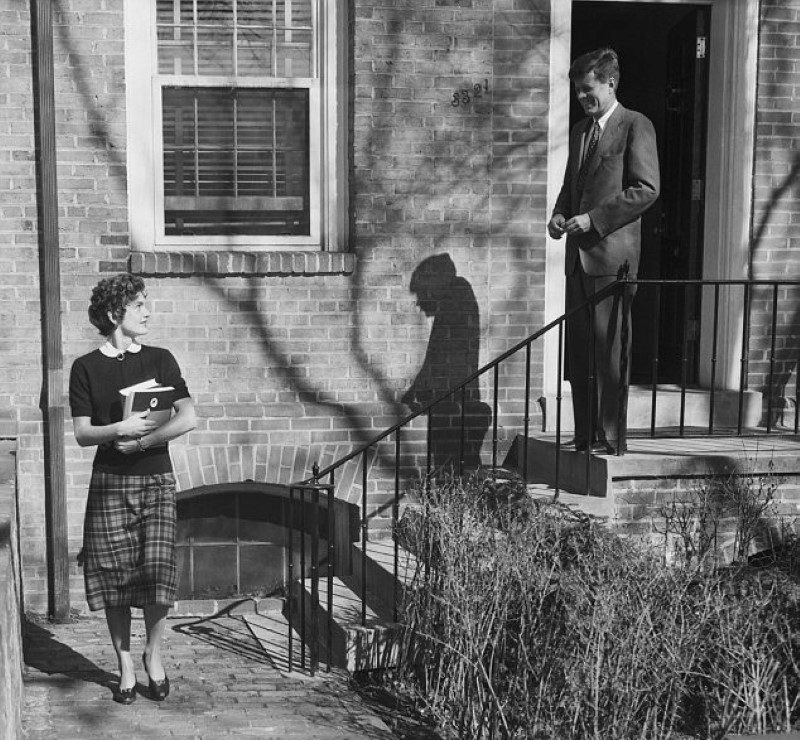Dare to Try a Ghost Tour of Georgetown?
By • October 12, 2022 0 6113

Do you believe in ghosts? Often asked around Halloween, this simple query tends to elicit responses ranging from contemptuous dismissal to wholehearted embrace, with stories in the mix. Whether or not you’ve ever encountered ghoulish phantasms, however, it’s worth taking a Ghosts of Georgetown Walking Tour from “DC By Foot.”

Courtesy Beth Saunders, art historian, curator and head of special collections at the University of Maryland, Baltimore County. From her lecture on “Photos of Ghosts” at Profits and Pints event.
“Among the historic streets, manicured gardens and Victorian row houses of D.C.’s finest neighborhood lie deep, dark secrets about a forgotten past,” their website whispers. “Come along to hear about the ghosts and spirits that still haunt these streets… if you dare.”
As a proud skeptic, I nevertheless plunked down $35 last Sunday evening, ventured to the gardens of The Old Stone House at 3051 M Street NW and joined in a 1.5 hour and 1 mile walking tour with 10 others – including friendly yet suggestible tourists from Germany and Texas – to shiver with frisson at “stories of curses, eerie coincidences, and of course a few haunted houses” on our eventual way to the Exorcist Steps at 36th and Prospect Streets NW.
Our tour guide, Eli Whykell, a young former attorney and diligent local historian, was set to lead the way in the crisp October air. By day Whykell leads sober-minded history tours through the neighborhood, but by night he ventures to the “darker side of Georgetown.”
As Eli launched into local ghost folklore, his knack for insightful and detailed story-telling punctuated by well-researched details and wry wit manifested. Soon we were all contemplating how much Georgetown life has been shaped by memories of the dead and how often the evils people commit while alive linger long after they’re dead and buried.
And the buried dead often “come to life” in Georgetown owing to thousands of years of human burials beneath Georgetowner’s feet here stretching back to the pre-Colonial Native American world. During home renovations, skeletal remains are often uncovered in the soil.

Georgetown’s Oak Hill Cemetery. Photo by John Dean.
At the Old Stone House built in 1765, something on the third floor late at night is said to bring on a choking sensation. Several mysterious ghosts in addition to George Washington’s are said to lurk about Georgetown’s “most haunted house.” In the 1960s, some Georgetown University students came to the site with a Ouiji board but ended up running away in horror.

Our tour began at “Georgetown’s Most Haunted House,” The Old Stone House located at 3051 M Street, NW in the Georgetown. Built in 1765, the Old Stone House is the city’s oldest building on its original foundation. Wikimedia Commons.
Near 30th and N Streets NW at the site of the Colonial, Lydia English’s creepy seminary boarding school for young women was converted to a Civil War hospital. Ghastly amputations from wounded soldiers piled up on the bricked sidewalks and the mortuary in the basement held many of the dead. In recent times, “people have said it just constantly feels like someone’s staring at you when there’s nobody around. They don’t like being here… and feeling these cold chills going down their spines,” Whykell intoned, before revealing physical signs of ghostly children’s lingering spirits.
At the Laird-Dunlop House at 3014 N Street NW, we hear of the extraordinarily tragic connection between one of its inhabitants and four separate presidential assassinations. Some sort of curse seemed to have befallen Robert Todd Lincoln who was not only haunted by his father Abraham Lincoln’s 1865 assassination, but managed to be within feet of Garfield’s (1881) and McKinley’s (1901) later assassinations as well. But how could he also be connected to John F. Kennedy’s 1963 assassination? Was it just a coincidence that Jacqueline Kennedy’s “Mourning Home” after JFK’s assassination was just a few doors down?

“There is a certain fatality about presidential functions when I am present,” President Lincoln’s son, Robert Todd Lincoln (left), was purported to have said. Was it a curse? Getty image.
Nearby, we stop in front of the Georgetown house where President Lincoln attended a seance to commune with his dead son Willie’s ghost. One might be surprised that Lincoln – a self-trained attorney known for his logical bent of mind – would attend such a ritual. But, who’s to say?
Soon we come upon the site of a Civil War “checkpoint” along N Street through which famous socialite and notorious Confederate spy Rose Greenhow ran encrypted messages to her contacts across the river to Virginia. As Greenhow tipped off Confederate generals about pending Union attacks on Richmond that might have ended the war quickly, she helped prolong a bloody war that would render hundreds of thousands more dead in the next four years. But why was her own death so particularly creepy?
Now we stroll to Foxhall Manor at 3123 Dumbarton Street NW. The story-telling is fully elaborated and fun here. But, also believable in a weird way. One participant from Texas exclaims “Oh My God!” at one point. Why did the home’s 3rd floor lights turn off exactly at 10:00 p.m. each evening? And who was the elder Mary Poppins-like figure who showed up years later to end the house’s spell?
As we pass Martin’s Tavern at 1264 Wisconsin Ave. NW, we learn about contending theories over where John F. Kennedy actually proposed to Jacqueline Bouvier. But as a trencherman, this little docenting tidbit stood out to me: JFK’s usual breakfast at Martin’s included “hash browns, rye toast, orange juice, coffee, fried eggs, bacon and on the weekend, Eggs Benedict.” So, “if you don’t believe in ghosts,” our tour guide says side-eyeing my way, “you’ve got to at least believe in the spirits of cholesterol that’ll come back to get you!”

The Kennedy mystique continues to haunt Georgetown… Photo courtesy DMarilin.com.
Along the way, we learn about the Fire Insurance Markers on Georgetown homes and some of the ghastly things that happened if owners had a fire. We learn about the Haint Blue porch ceiling paint used to ward off demons and spirits deriving from west African Gullah traditions.
Next, we pause at one of the most haunted environs in Georgetown, Halcyon House at 3400 Prospect St. NW. Built in 1789 by George Stoddert the first Secretary of the Navy, here’s a site where “George Washington really did hang out” along with Charles Pierre L’Enfant who designed the home’s gardens and crypt.
But it’s not their ghosts who haunt here. No one would live in the home for a century following Stoddert’s departure in 1801. Then a bizarre figure named Albert Clemens who falsely claimed to be Mark Twain’s nephew moves in and goes wild with the place. “To say Albert was a little eccentric and odd is a wee bit of an understatement,” we’re told. He adorned the home with treasures from his foreign travels, including 9-foot marble angels, suits of armor and Egyptian mummies which Clemens believed would enhance his vitality. He seemed obsessed with building a haunted mansion, constructing “rooms within rooms within rooms leading to a tiny table and chair no one was small enough to sit in.” Doors would “open to other doors which would open to other doors” until you’d get to a brick wall. External columns didn’t reach the ground. Mysterious tunnels leading to the Potomac River were sealed up and then opened again. Clemens and his devoted carpenter lived in the mansion’s crypt.

At Halcyon House, eccentric owner Albert Clemens “adorned the home with treasures from his foreign travels, including 9-foot marble angels, suits of armor and Egyptian mummies which [he] believed would enhance his vitality.” Library of Congress.
When Georgetown University owned Halcyon House and turned it into a women’s dormitory the mansion was so frightening it was sold-off after a year. Reports from three young women were particularly horrifying. A few years ago, a tour guide with Boy Scouts came to see Halcyon House but they scrambled away in fear. Why?
But, for all its eccentricities, Halcyon House really doesn’t compare to The Exorcist Steps when it comes to frightful stories. Before plunging into the horror, we learn about “The Tombs” bar across the way and the strange and massive Transformer sculptures constructed in front of a home just down the street.
In 1972, key scenes for the classic horror film The Exorcist directed by William Friedkin were filmed here, using the home at 3600 Prospect Street NW for exterior shots and the steep steps down to M Street for the climactic scene. In the film, an 11-year-old girl named Regan and her mom, played by Ellen Burstyn, have come to Georgetown because her mom’s an actress in a movie filming here. Horrifying signs of demonic possession soon take hold of Regan compelling her mom to summon an exorcist to try to save her.
The film is based on the 1971 novel of the same name by William Peter Blatty who was a student at Georgetown University. Blatty had come upon the story of a real-life exorcism that took place nearby in 1949 for a young boy named Roland Doe. Many of the horror elements in Friedkin’s film were reported in Doe’s case, including: messages bubbling up on his skin, demonic voicing, super-human strength and speaking in tongues.

The possessed child, Regan, from the 1973 horror film The Exorcist. IMDb photo.
But the film itself seemed to have a sort of curse surrounding it. Friedkin was known to be cruel and obsessive. To elicit real screams of horror from Ellen Burstyn, he had her suspension harness yanked so tightly that she received permanent spinal injuries. During filming, he refrigerated Regan’s bedroom intolerably. The voice actor who played the demon was forced to gargle raw eggs and be painfully strapped to a chair. Hollywood sets near The Exorcist’s burned down mysteriously. Multiple cast members died before the film was released and one – a male nurse in the hospital scene – went on to become a serial killer. Even at the film’s release in Rome, near the Vatican, lightning knocked down the 400-year-old church steeple across the street. Watching the film, stories of audience members fainting from fear and throwing up were rife.
At the conclusion of the tour, I invited participants to take a happy picture on the dark Exorcist Steps,. They chose instead to remain safely at the top and soon scattered about Georgetown.

The author invited the group down the Exorcist Steps for a photo, but they chose to stay at the top… Photo by Chris Jones.
For information on the Ghost Tour of Georgetown see https://freetoursbyfoot.com/washington-dc-tours/.

